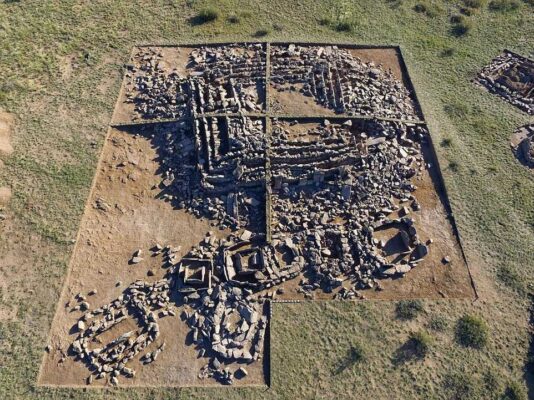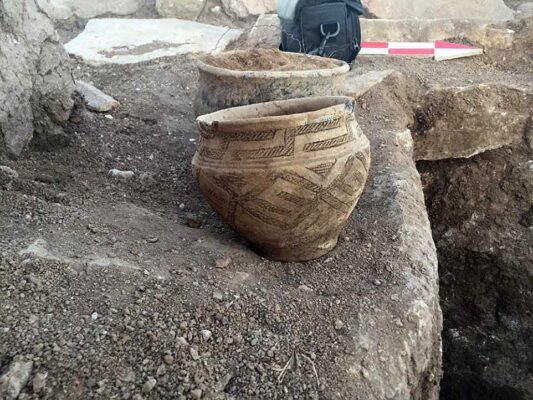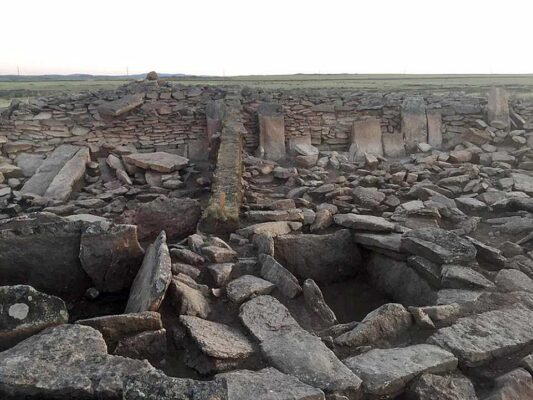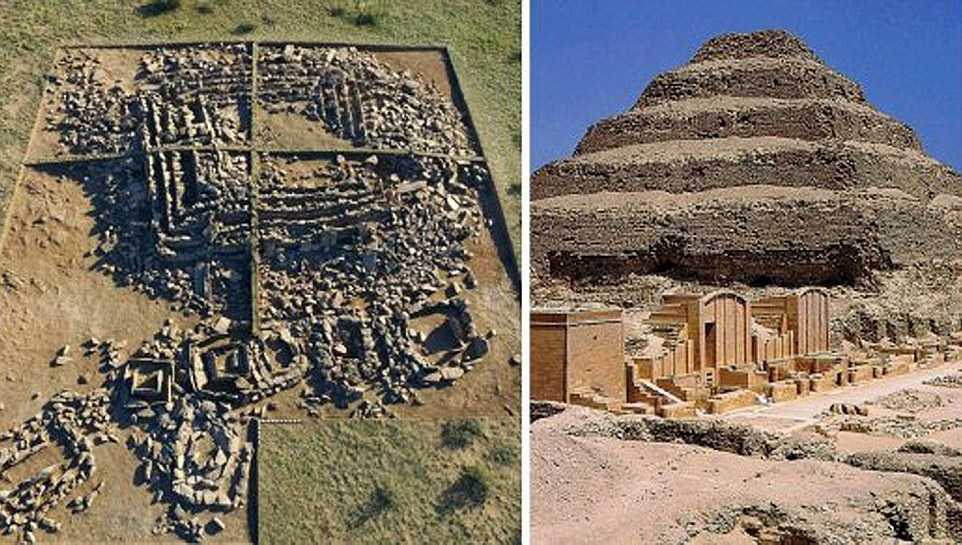The discovery of a 3,400-year-old pyramid in Kazakhstan has captured the attention of historians, archaeologists, and enthusiasts worldwide. This remarkable structure, unearthed in the Karaganda region, sheds light on ancient civilizations of Central Asia and their advanced architectural capabilities. With its unique design and multiple purposes, this pyramid has become a focal point for understanding the rich cultural heritage of the region. Follow archeology.dulichvn.net to discover many hidden mysteries that have yet to be discovered.

Unearthing the Ancient Multipurpose Pyramid
The Discovery and Excavation
In 2016, archaeologist Viktor Novozhenov and his team unearthed a groundbreaking find in the heart of Kazakhstan’s Karaganda region—a 3,400-year-old pyramid that had remained hidden beneath layers of soil for millennia. This extraordinary discovery immediately captivated experts due to its striking resemblance to the iconic pyramids of Egypt. However, upon closer study, it became evident that this structure predated the Egyptian pyramids, marking it as a unique architectural achievement that reflected the ingenuity of the Bronze Age civilizations in Central Asia.
Unlike its Egyptian counterparts, the Kazakh pyramid served a distinct purpose, blending religious, societal, and practical functions into one cohesive structure. The excavation not only revealed the pyramid itself but also uncovered an array of artifacts and architectural details that painted a vivid picture of the life and culture of its creators.
Location and Context
Nestled in the Sary-Arka steppe near the village of Toktamys, this pyramid is part of a larger archaeological complex that speaks volumes about the Bronze Age societies of the region. The site includes burial mounds, smaller stone structures, and scattered artifacts, indicating it was a hub of significant ceremonial and communal activities.
The steppes of Central Asia, often seen as vast and barren, are rich with hidden historical treasures. The pyramid’s location at the heart of these steppes highlights its importance as a central point for rituals, gatherings, and possibly astronomical observations. Its placement also suggests that the builders carefully considered the natural landscape, integrating the structure into the environment to enhance its spiritual or symbolic significance.
Materials and Construction
The pyramid’s construction reveals a level of architectural sophistication that is both impressive and enigmatic. Built primarily from locally sourced flat stones, the structure follows a step-like design, with each tier meticulously aligned to create a symmetrical and imposing form. This design not only gave the pyramid its distinctive appearance but also ensured its durability against the harsh elements of the steppe.
At the heart of the pyramid lies a central chamber, likely used for ceremonial or burial purposes, surrounded by smaller annexes that may have served as storage spaces, ritual rooms, or secondary burial sites. This layout reflects a careful balance between functionality and symbolic design, suggesting the structure was used for multiple purposes, including religious ceremonies, communal gatherings, and possibly as a marker of astronomical significance.
The engineering precision evident in the pyramid underscores the advanced knowledge of its builders, who skillfully combined practicality with spiritual intent. The use of locally available materials further demonstrates their resourcefulness, while the enduring stability of the structure stands as a testament to their ingenuity and craftsmanship.
In conclusion, the discovery, location, and construction of the Kazakh pyramid not only highlight the architectural achievements of ancient Central Asian societies but also offer a deeper understanding of their cultural, spiritual, and practical lives. This site is a beacon of historical significance, waiting to reveal even more about the sophisticated civilizations that once thrived in the steppes of Kazakhstan.

The Purpose Behind the Pyramid
Religious Significance
The Kazakh pyramid likely held profound spiritual importance for the nomadic tribes that inhabited the region during the Bronze Age. Its central chamber, positioned at the heart of the structure, is believed to have been a sacred space for performing rituals honoring deities or ancestral spirits. Such ceremonies would have been deeply rooted in the tribes’ belief systems, reflecting a worldview that saw a close connection between the natural environment, the cosmos, and their spiritual existence.
The pyramid’s design, with its step-like tiers ascending toward the sky, may symbolize an attempt to bridge the earthly and the divine. This architectural symbolism is consistent with other ancient cultures that viewed pyramidal shapes as a means of reaching out to higher powers. The placement of the pyramid in the open steppe further reinforces its spiritual purpose, as the vast and unspoiled landscape could have provided a fitting backdrop for sacred gatherings or seasonal rites.
Burial Practices
Archaeological evidence points to the pyramid’s role as a burial site for a prominent tribal leader or noble. Within its central chamber, researchers uncovered human remains alongside grave goods such as pottery, tools, and ornamental objects. These artifacts not only underscore the individual’s elevated status within their community but also provide insight into the cultural practices surrounding death and the afterlife.
The inclusion of such grave goods suggests a belief in the continuation of life beyond death, with these items meant to accompany the deceased into the afterlife. This practice aligns with widespread Bronze Age traditions, where the preparation of the dead reflected both reverence and a desire to ensure their comfort and status in the next world. The pyramid’s construction, therefore, serves as a monumental testament to the community’s respect and veneration for their leaders, reinforcing their societal hierarchy and spiritual beliefs.
Astronomical Observations
One of the most intriguing aspects of the pyramid is its potential role as an astronomical observatory. Scholars have noted that the structure’s orientation aligns with significant celestial bodies, suggesting that the builders had a keen understanding of the movements of the sun, moon, and stars.
This alignment may have been instrumental in tracking seasonal changes, enabling the nomads to time their agricultural activities or migratory patterns with precision. Furthermore, the pyramid’s layout could have facilitated rituals tied to celestial events, such as solstices or equinoxes, which were often imbued with spiritual significance in ancient cultures.
The dual role of the pyramid as both a ceremonial site and an astronomical tool demonstrates the intricate interplay between spirituality and practical knowledge in the lives of its creators. It reflects a worldview where the cosmos was not just a source of wonder but also a guide for daily life and a central element in their religious practices.

Significance of the Discovery
Insights into Central Asian History
The discovery of the 3,400-year-old pyramid in Kazakhstan has unveiled a treasure trove of knowledge about the Bronze Age civilizations of Central Asia. Long overshadowed by the monumental achievements of regions like Egypt and Mesopotamia, the societies of the Central Asian steppes are now recognized for their advanced architectural capabilities and cultural sophistication.
This pyramid challenges traditional narratives that associate complex construction techniques and monumental structures solely with ancient Egypt or Mesopotamia. Its unique design and multifunctional purpose demonstrate that Central Asia was home to innovative and resourceful communities capable of creating enduring architectural marvels. The site offers clues about the spiritual beliefs, social hierarchies, and scientific knowledge of the region’s ancient inhabitants, painting a richer and more nuanced picture of the global Bronze Age.
Advancements in Archaeology
The excavation of this pyramid highlights the untapped potential of archaeological exploration in lesser-studied regions like Kazakhstan. For decades, Central Asia was often overlooked in favor of more well-documented historical sites. However, this discovery proves that the region holds significant historical importance, warranting deeper investigation and preservation.
The pyramid also serves as a testament to the global interconnectedness of ancient cultures. While its design is distinct, similarities in purpose and symbolism with other ancient structures across the world—such as Egypt’s pyramids or Mesopotamian ziggurats—underscore the shared ingenuity and cultural aspirations of humanity. This discovery encourages archaeologists to broaden their perspectives, seeking connections between distant civilizations and reevaluating the influence of Central Asian societies on global history.
Preservation and Tourism
Recognizing the pyramid’s cultural and historical significance, efforts are now focused on its preservation and promotion. Local authorities, in collaboration with archaeologists and historians, are working to protect the site from natural erosion and human interference. Advanced techniques, such as digital mapping and 3D reconstruction, are being employed to document and restore the structure while ensuring its integrity for future generations.
The pyramid is also being positioned as a cultural tourism destination, offering visitors an opportunity to experience the rich heritage of Kazakhstan. Guided tours, educational programs, and interactive exhibitions are being planned to immerse visitors in the historical and cultural context of the site. By showcasing this ancient marvel, Kazakhstan aims to raise awareness of its historical contributions and position itself as a key player in the global heritage landscape.
See more: Norsun Tepe: Unlocking the Mysteries of an Ancient Temple
Conclusion
The unearthing of the 3,400-year-old pyramid in Kazakhstan marks a significant milestone in understanding ancient civilizations of Central Asia. This multipurpose structure, blending ceremonial, burial, and astronomical functions, provides a window into the lives and beliefs of its creators. As research continues, this discovery not only enriches our knowledge of human history but also underscores the enduring legacy of innovation and spirituality across cultures.


CÁC TIN KHÁC
Mary Walton: The Forgotten Inventor Who Helped Clean Up America’s Cities
Tomb of Queen Nefertari in the Valley of the Queens, Egypt
Discover the Hypostyle Hall of the Temple of Hathor at Dendera
Venus de Losange: Unveiling the Mystery of a 20,000-Year-Old Paleolithic Icon